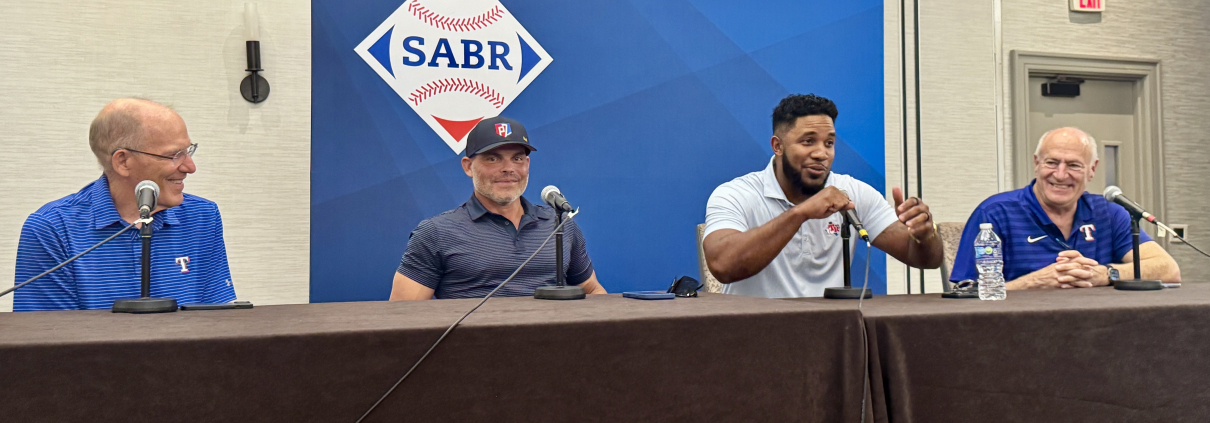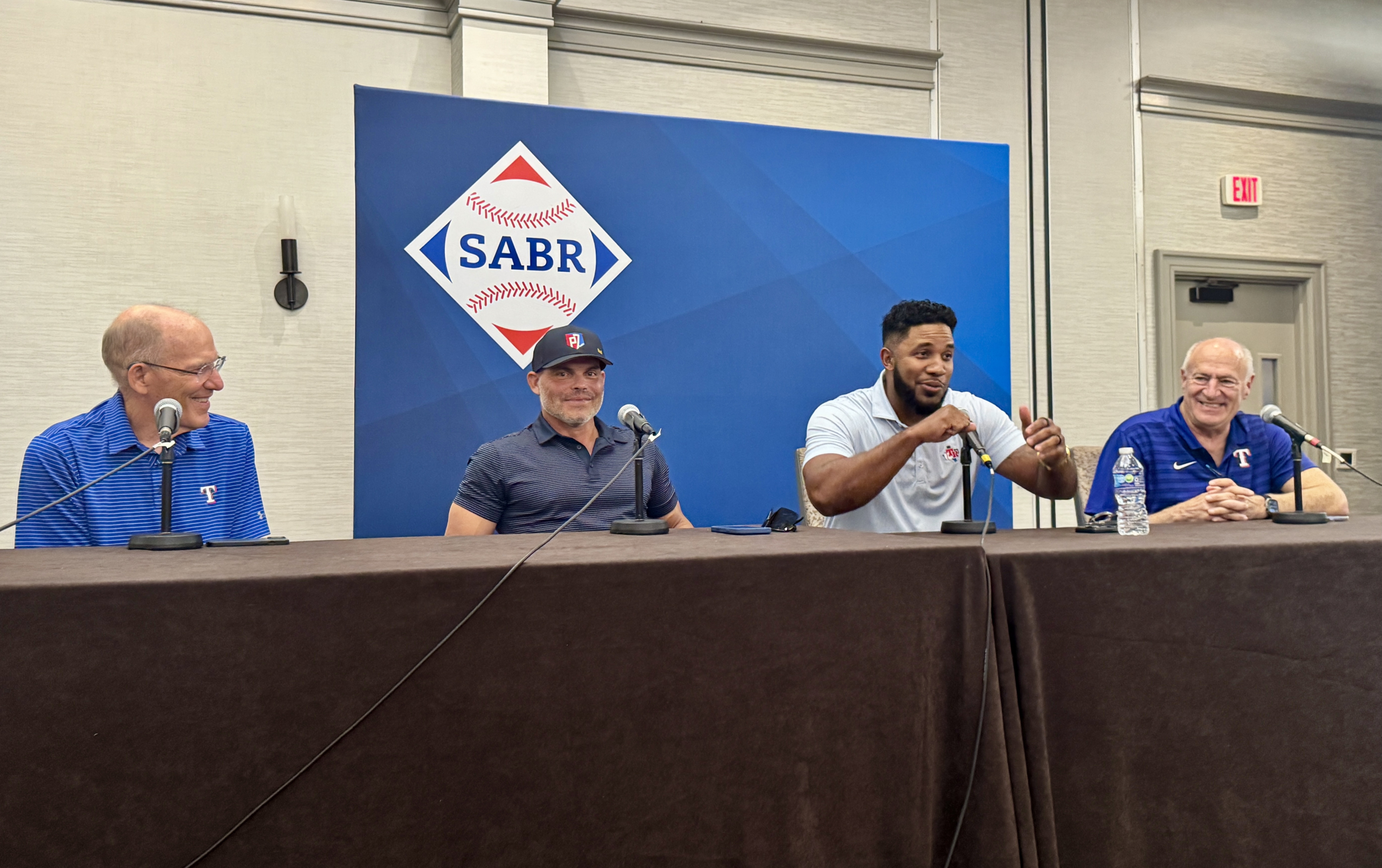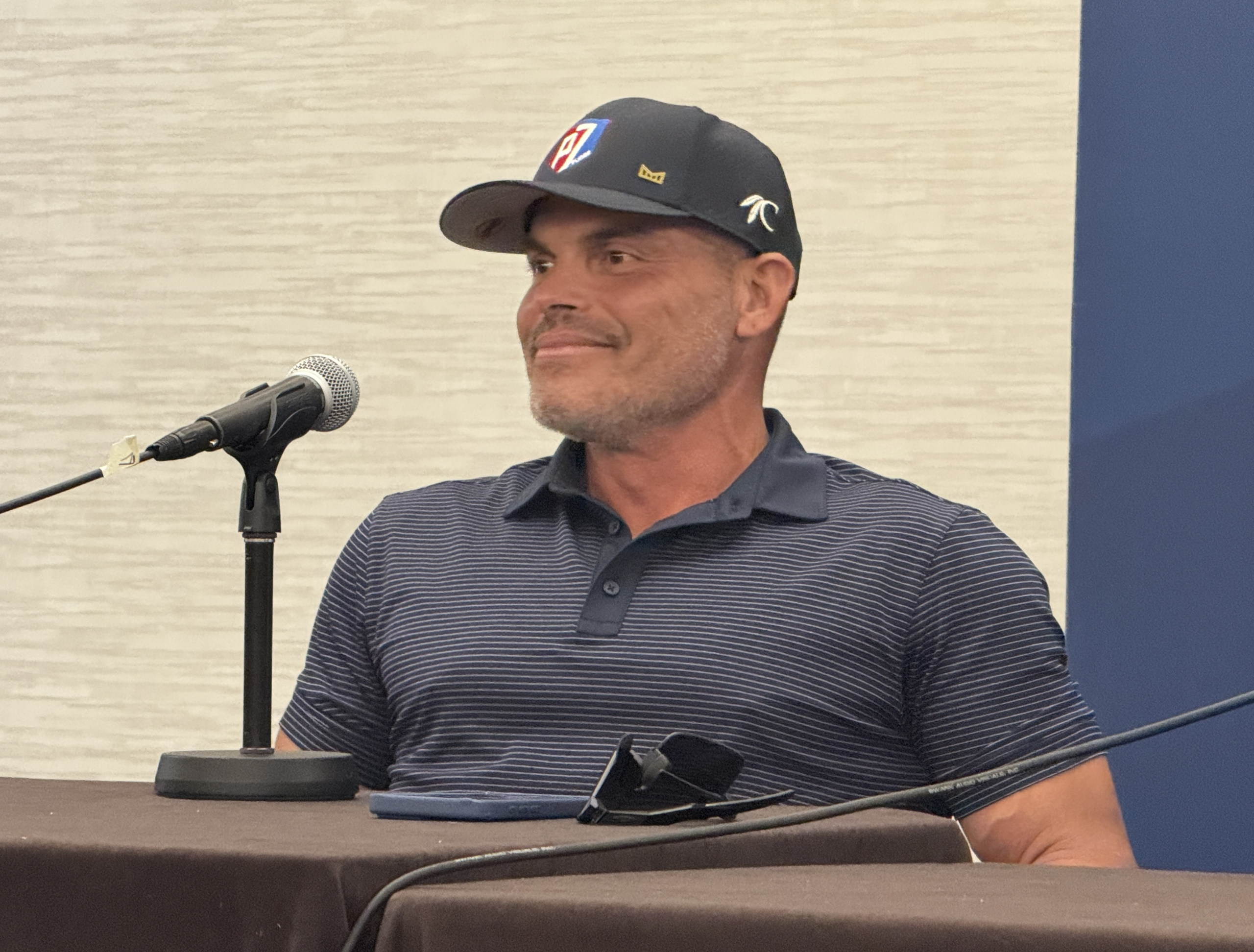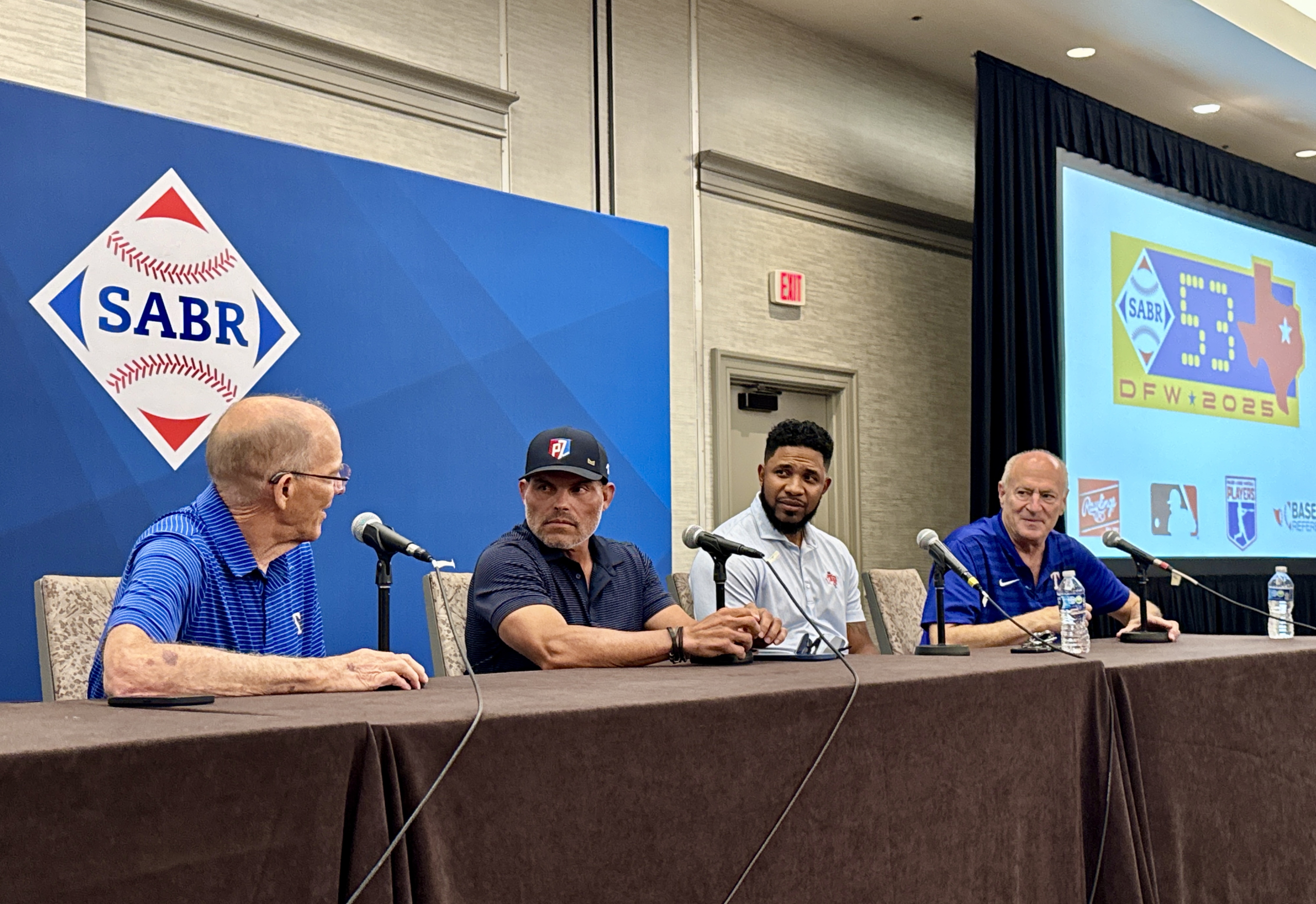SABR 53: Listen to highlights from Texas Rangers Hitters Panel with Iván Rodríguez, Elvis Andrus, and Tom Grieve
On Thursday, June 26, 2025, the Texas Rangers Hitters Panel was held at SABR 53 at the Westin DFW Airport Hotel in Irving, Texas.
Panelists included Iván Rodríguez, who was inducted into the National Baseball Hall of Fame in 2017 and is considered one of the greatest defensive catchers in the history of the game, earning 13 Gold Glove Awards, 14 All-Star selections, and the 1999 American League MVP Award; Elvis Andrus, a two-time American League All-Star at shortstop who helped lead the Rangers to back-to-back World Series in 2010 and 2011; and Tom Grieve, known as “Mr. Ranger,” who has spent five decades in baseball as a player, executive, and broadcaster with the Texas Rangers. The panel was moderated by Eric Nadel, a Texas Rangers broadcaster since 1979 and the 2014 recipient of the Baseball Hall of Fame’s Ford C. Frick Award.
- Audio: Click here to listen to the SABR 53 Hitters Panel (55:54; MP3)
Here are some highlights:
ON LEARNING HOW TO HIT FOR POWER
- Andrus: “Now the game is completely different. No matter if you’re 5-foot-5, like (José) Altuve. Everyone goes up and hits homers. When I came up … Ron Washington, my manager, said, ‘Do what you do best, be the best at what you do.’ For me, that was getting hits, stealing bases, playing great defense. I worked to be the best at that. I think it’s very special when you’re able to learn something else when you’re along in your career. For me it was that year (2017) when I hit all those homers (20). I amazed myself. That was a pretty unique year. After (I broke my elbow in 2018), my whole swing had to change. I could not extend.”
ON PICKING OUT THE RIGHT BAT
- Rodríguez: “My whole career, it was a P72 bat, 34 (inches and) 33 (ounces), from 1991 all the way until 2012. I used the same bat, no changes: black, double-dipped Louisville Slugger. And the reason it was 33 (ounces), I worked with Orlando Cepeda in San Francisco and he felt my bat. It was a P72, 34 (inches) and 30 ounces. He said, ‘This is a toothpick. You need to hit with something heavier and throw your hands, and make the speed of the pitcher give you power.’ I said, ‘Oh my god, this thing is heavy but I have to use it.’ And the first time I used a 34/33, I had three hits and a home run. And since that day, I used that bat. … Sometimes you make adjustments in the season. But the more tired I was, the more the bat helped me to use my hands. And I put up some great numbers in August and September, those were the best numbers in my career.”
- Grieve: “I don’t have many regrets, but one regret I have is I used a bat that was too big. When I played, we weren’t as strong as the players today. But as a group, our bats were much bigger than they are today. I used a bat that had a fairly big handle and a big barrel, and it was 35 inches, 33 ounces. I never thought twice about it. But as I’ve watched baseball over the years, I pick up the bats the players are using, the guys that are hitting home runs — there’s no bat like that. My son (Ben) picked up a bat at home and he said, ‘Is like the weighted bat you swing in the on-deck circle?’ He’s 40 pounds heavier than I am and he wouldn’t even think of using that bat. … I feel like now that my whole career, I used a bat that was too big. … But everyone used them and there’s nothing I can do about it now. I wish I could go back and use a different bat.”
ON PREGAME PREPARATION AND SCOUTING REPORTS
- Rodríguez: “I was very good at anticipating the game. That’s why I think I was very successful because I can pick things up before the play happens. I threw a lot of people out on the bases because I studied the counts, I studied when the runner was going to go. … It just comes to preparation, being ready as a catcher. As a hitter, I don’t have anything to tell you. I just see the ball and hit it.”
- Andrus: “When I got to the big leagues in 2009, you’d see the video and go through the (opponents’) whole rotation and bullpen. But it was very short. Tonight, it’s two pitchers, the other three we don’t even worry about it. Rudy (Jaramillo, the Rangers’ hitting coach) was very simple and I loved it. At the end of the career, it was very boring. It felt like I was in a university. The meeting would take like 40 minutes and I was thinking, ‘Are we going to take a test or are we playing baseball?’ … One thing you learn playing with guys like Pudge, Adrian (Beltre), Michael (Young), Ian (Kinsler), that was my job. You have your iPad, you go home at night and you’re facing Félix Hernández the next day, that would be my homework. Pretty much in the meetings, I was always trying to be annoying to someone. But you already had your plan and you knew what you were going to do and attack (the pitcher) that day.”
ON THE PITCHERS YOU ENJOYED FACING THE MOST
- Andrus: “Félix was good because he was so nasty. A lot of people ask me how I was able to lay off so many of his changeups or splitters. He asked me that, too. For some reason, I never swung at his split-finger, which struck out 10 or 12 guys every game. My answer kind of surprised him. I said, ‘Dude, I do want to swing but it’s so nasty that you feel like someone’s holding you back.’ … But my answer is kind of easy: anyone in the Cleveland Indians organization. No matter who was the pitcher, that was a team where I was like Pudge — I watched no video, I just knew I was going to do good. Cleveland was that team for me.”
- Rodríguez: “They were all tough. They were all major-league pitchers and they were all very talented. But I always hit really good against (Roger) Clemens and power pitchers. I was ready for a fastball all the time. When you’re facing guys like Pedro Martínez, Clemens, Randy Johnson, what am I going to be looking at? Fastballs! If you’re going to be throwing me a fastball, that toothpick, the black P72, is going to be on it. And I just hope I don’t miss it.”
- Grieve: “Personally, I was a really streaky hitter to an extreme. If I was in a good streak, it really didn’t matter to me who was pitching. And if I was in a bad streak, it didn’t matter. One pitcher I would never want to face, if I had to pick one, was Jim Palmer. He was really tall and had a big windup and threw over the top and the ball came down on you. From the dugout, it didn’t look like he was throwing very hard. We didn’t talk about spin rate back then, but you can pick the pitchers who had good spin rate because their fastballs seemed to stay on a plane longer than others. And he was one of them. He must have had that good spin rate.”
ON TOUCHING ADRIAN BELTRE’S HEAD
- Andrus: “I think he knew what was going to happen. The risk for me was getting slapped. If you know Adrian, if you shake his hand, he had gorilla hands. For me, it was not touching the head … it was not getting killed out there after I touched his head! He knew, he was just being playful. We did it when he hit a homer. He was never going to be 100% mad, he just hit a home run. So we always used that to our advantage.”
For more coverage of SABR 53, visit SABR.org/convention.
Originally published: July 8, 2025. Last Updated: July 8, 2025.

